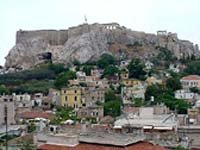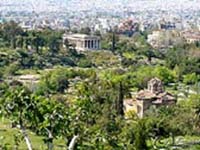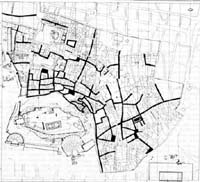
A Purifying that paid off - Part 1
The area that nestles around the ancient Acropolis in Athens is known as the Plaka. Many people may know about the Plaka but not everyone has the same idea about it. Thousands of tourists think of it as alternately a “fun area” where Athens night life begins and ends, many more, if they went to Greece in the early 1980’s, will remember Plaka as a vulgar, drug-ridden area. For the former, there is still a night life in Plaka, but nothing as frenetic and crowded as it used to be, but fun nonetheless, for the latter, that scene has gone, hopefully for good.
Hopefully, this article written back in the 1990’s will encourage people to see the Plaka area and the Acropolis with new eyes. If it hadn’t been for a team of dedicated people, the whole area could have been razed to the ground, but more on that later.
The Plaka is now a place to enjoy, many aspects are better than they ever were, the tavernas still work well, nice coffee shops and a few bars and the inevitable souvenir shops. But Plaka is a neighbourhood and becoming more so. Many families who had lived in the Plaka for years, moved out when the area attracted drug users and the troubles began. Most of today’s Plaka is there thanks to a team which, for some nearly forty years have toiled to re-plan the area so as to lessen some of its woes, from traffic problems to too many decibels, to ridding the area of nuisance elements and restoring it as a place where people can live.

During the period from 1961 to 1975 some three quarters of the inhabitants of the Plaka old town of Athens moved away. Professor Dionysis A.Zivas, the architect who headed the team responsible for “saving” the Plaka area told me back in 1990 when I still lived in Athens, that the area was well worth saving. He looked upon the task as more of a “purification” than a salvation attempt.
The detailed study issued in 1977 by the team headed by professor Zivas, who was then Director of the Archeological Department at the National technical University of Athens, makes fascinating reading. The object of the study was to note down and analyse problems connected with the area of the “Old City of Athens” or the Plaka quarter. The basic target of this research work was to “draft feasible proposals for the preservation of the character, the display of ancient monuments and the incorporation of the functions of a modern city into the “Old City of Athens”.
The team consisted of archeologists, architects, an economist, sociologist, lawyer and statistician. The work put into the study was enormous in its intensity and scope. The historic and archeological details, characteristic historic stages in the city’s evolution through ancient by the Byzantine age, the Frankish and Ottoman rules, War of Independence and as capital of the new Greek state.
The description of ancient monuments covered the Acropolis including amazing things such as the Ancient Agora, the Roman Forum, the Clock of Andronikos Kyrristos or “Tower of the Winds”, Hadrian’s Library, Lysikrates Monument, the Odeon of Pericles, the Peripatos, the Pantheon, Agora of Theseus, Thession, Gymnasium of Ptolemaios and the Diogheneion.

Urban data covered everything from land use, ownership and size of plots, coverage of built-up plots, number of storeys, functions, sizes of dwellings, building regulations, streets and traffic and area networks. The data on buildings included their morphological evaluation, deformation of the original forms, state of repair, architectural style and date of construction. The social anatomy of the Plaka including residential mobility, quality of life including housing conditions and use of free time plus the then public opinion about Plaka.
Here is where some surprises came in. Several opinions had it that all Plaka residents were surely descendents or from ‘old families’, this was not the case. Out of the household heads studied of those not born in the Plaka, only 24% came straight to live there from a village or a provincial town. All the rest had already had the experience of urban living and therefore no problem of adaptation to a different social environment. About two thirds of the household heads moved to Plaka since 1955. The remaining third were on the whole, pre-war residents. The wealthier inhabitants had, by the time of the study, already expressed a wish to leave for the suburbs or elsewhere in Athens.
At the time of the study there was a different scene in Plaka from when this writer first set foot there in the late 1960’s. The village atmosphere then prevailed, but within a very short space of time, the area had come under the “vulgar” influence that ruled, including the drug scene, so-called Hippie types and transients who were not in the least interested in the Plaka as an Old City but as a convenient and cheap means of living and dealing in whatever they chose to deal in. No doubt by today’s standards this may have been more innocent, but drugs is drugs and the abuse of these always causes mayhem where they are used.
The mere fact that these types eventually faded from the area was enough for Professor Zivas to accept a pat on the back. He was however, modest about his achievements and that of his team. One would have thought that since plenty of tavernas and night clubs closed down and moved out of the area, that the study team was unaware of the fact that tourism played an important role in the area. This is not the case, tourism was taken into consideration as was the nuisance value of the form it had taken in the Plaka district.
Noise and traffic were among the main objections of Plaka residents to the places which most attracted tourists. In the opinion of residents at that time, foreign tourists were drawn to Plaka mainly by the Acropolis and the archeological sights as well as the picturesque look or the streets and buildings and only in rare cases by the night entertainment.
The study stated: “The view which has been formal on this matter is that there are some positive cultural gains for Greek society as a whole, to be derived from the interaction of its members, older and younger with the continuously increasing number of foreign visitors importing more varied and informal ways of life.” However, it was also felt that tourism was destroying little by little, precisely what tourists expected to see in Plaka. The area came under a UNESCO study a few years earlier and three main dangers were then felt to be paramount:
“It covers the ancient city centre which cannot possibly be excavated without demolishing the present structures, a large section already having thus been demolished to permit excavation of the ancient Agora. These excavations are spreading further. Its very position is next to that of the commercial centre of Athens, the latter encroaching all the time. The old houses have been replaced by new, higher blocks of flats completely out of scale compared to the old town plan network. The character of this histories quarter is such that it exerts a strong attraction upon tourists.”
ARCHEOLOGISTS VERSUS CONSERVATIONISTS?
At the time I wrote that, there would probably be a mountain of mail (pre-emails!) from the archeologists who wished to extend the then present excavations to uncover whatever the then current Plaka buildings hid from ancient times. It should be noted however, much of the already uncovered area was fascinating, the area as a whole has its own bounty of history, that of a characteristic whole. This was my own opinion at the time but I felt that if the ancient ruins were further uncovered, it would be at the disadvantage of the Plaka area and this had nothing to do with what tourists thought.
Having lived in Athens under the unpopular Junta, I recalled having been surreptitiously given a petition to sign. The petition was accompanied by aerial photos of the Plaka around the Acropolis. These photos showed ceramic roofs with large red crosses on them, it was intended to raze the Plaka to the ground to uncover more of the Acropolis.
One could argue over and again the votes for and against doing this very thing. Yes, we may have discovered more of ancient Greece but what about the several hundred years of modern Greek history? Surely modern history should be saved as well? Sometimes history is encapsulated in a few months and there are remnants and monuments to this. When it’s a couple of hundred years at least, surely this counts? Argue against me if you will. Fortunately this Juntarian idea was quashed, they were nervous of foreigners in their midst and there were plenty of them, and probably caved in. Fortunately for Greece, the Junta was sent packing in 1974.
The Plaka then came under Professor Zivas’ wise eyes. Proposals for the preservation and revival of the area were laid out in detail in the study. The extent of the area to be preserved and the fixing of boundaries, four alternative proposals were included, buildings were noted as to their worth, functional structures and traffic networks thence economic elements which included acquisitions of land, indirect intervention and an estimate of the then relevant expenditure. I don’t recall the figures but by today’s standards it was peanuts.

The laws and legal situation which prevailed previously were inadequate to the task in hand, that of preserving the Old City of Athens. Fundamental laws were in effect, but had hardly been enacted in any real form. Protection measures were pointed out which in fact had a bad effect on the Plaka resident. The law determined in each case, who was responsible for the repair work and other operations and the Archeological Council decided on whether they be carried out or not. Thus, as far as ancient historic monuments and structures anterior to 1830 were concerned, the repair work was carried out by the competent department of Restoration, while for newer monuments and structures this would be the task of the freeholders of the site (owners) in both cases the expenses had to be met by the latter.
Tough luck if your building was falling into disrepair and you couldn’t afford the expense of restoration. The state would then carry out the necessary work, contributing the necessary funds and hence: in cases where the owners were private individuals, the State was entitled to proceed to the acquisition of the structure. The new constitution in force took into consideration that it would be the responsibility of the State to protect natural and cultural environments, particularly of monuments and traditional elements and areas. The legislators were given wider scope for the protection and measures to be taken to guarantee an effective and integrated protection of the Cultural Heritage of an area.
Instead of ignoring more recent historical concepts and preserving only those which were of obviously ancient origin, the new laws gave protection to, one could say, a lifestyle as experienced over hundreds of years. If the Plaka had been excavated wholly, to uncover whatever lost ancient treasures are buried there, then the area, which covered several hundred years of more recent history, would have been lost forever. When ancient monuments occur in the centre of a Metropolis, this is obviously a problem which will naturally arise. Whereas in places such as Mexico where ancient civilizations are laid out on vast plains or in places in Greece where the same thing occurs (Akrotiri on Santorini for instance) the question hardly arises. The EC has helped in the preservation of “Other elements” of cultural architectural heritage i.e, old or traditional settlements, historic cities or quarters and generally, historic, urban environments of historic artistic, scientific and aesthetic interest.
The “Anafiotika” quarter is perhaps the most picturesque when it comes to cosy, small cottages clinging to the northern slopes of the bottom of the rock of the Acropolis. These houses began to be built at about the time of the dethronement of King Otto. Two builders from the island of Anafi solved the problem of housing their families by building two small cottages on an out-of-the-way piece of public ground, carving out and filling in the cavities of the rock, unobserved. The authorities (fortunately for today’s view) tolerated their presence and by turning a blind eye, opened up the way for other Anafiots to follow suit.
The Anafiotes were responsible for rebuilding from ruins two churches, the snow-white Church of St George of the Rock and the Church of Saint Symeon, which was painted on the lines of the Cathedral church of their new homeland. The need to save space is reflected in the unique architectural styles that prevail among the narrow lanes and steps of various shapes, twisting at different levels and representing the simple popular building sense of the inhabitants.
Professor Zivas and his team have been successful in many areas, they have reduced traffic, which was one of the main causes of decay to buildings and way of life in the area, now most of the streets in a whole area in the centre of the Plaka are pleasant to walk among and afford peace and quiet to its inhabitants. Traffic is still a thorn in the sides of the residents who formed a group with the aim of making the Plaka more of a neighbourhood where they may have the same facilities as other areas of Athens instead of only touristic ones.
The enormous problems such as sewerage, drainage, electricity and telephone lines, gas supplies, water supplies and public power and telecommunications networks all came under consideration. We see the benefits today. Of the four proposals, the one which took effect, or rather was put into effect, in Part 2.
NB: Professor Zivas has retired but I'm sure he still mentors the team he left behind.
Very nice history
Downvoting a post can decrease pending rewards and make it less visible. Common reasons:
Submit
I agree. I lived for many years in Athens and travelled widely and still think it's a wonderful place.
Downvoting a post can decrease pending rewards and make it less visible. Common reasons:
Submit
This post received a 1.5% upvote from @randowhale thanks to @sumayia! For more information, click here!
Downvoting a post can decrease pending rewards and make it less visible. Common reasons:
Submit